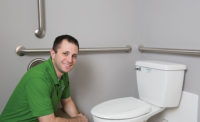There is evidence that, in human populations, SARS CoV is excreted in feces, vomit, respiratory secretions and urine. One outbreak cluster (the Amoy Gardens in Hong Kong), which affected 329 people and caused 42 deaths, was characterized by rapid spread of the infection between occupants of apartments in a multi-tower block complex. Modeling and simulation studies revealed that this spread was linked to fecal droplet transmission, which could be traced back to inadequately maintained water traps and reduced water use for bathroom cleaning, resulting in non-functional water locks of floor drains. This, combined with air movement instigated by overpowered bathroom extractor fans, created conditions that were highly conducive to virus transmission. The likelihood of re-entry of extracted air containing fecal droplets into other dwellings through upward air circulation in the narrow light wells between apartments added to the problem.
Linking Sewage to SARS
SARS and SARS CoV have focused interest on the link between sewage/sewerage and health, resulting in the need to control health risks associated with inadequate sewerage. A large number of diseases associated with inadequate water, sanitation and hygiene occur in populations in developing countries with lack of access to adequate sanitation.
Though the majority of the world's population uses some form of dry sanitation, especially among the rural poor and poor populations in urban and slum areas of cities in developing countries, there is insufficient evidence of the risk of SARS transmission through dry sanitation; it appears that the principal environmental risk is associated with water-borne sanitation.
Control Measures
To prevent entry of fecal droplets from sewage into the human/built environment, all connections to sewerage from the dwelling must be effectively sealed. Water seals in toilets are highly effective, but leaks may occur in pipes routing through buildings and from vent stacks, leaving no evidence of liquid leakage. Pressure differences caused by ventilation or air-conditioning between rooms or between the inside and outside of an apartment may exacerbate the risks associated with such leaks. Whenever possible, venting systems should be free of mechanical devices.There are also ways to interrupt virus transmission in environments where virus-containing droplets are most likely to be generated, i.e. healthcare facilities and toilets/bathrooms. Removal of the droplets from the built environment must be accompanied by measures to ensure that they cannot then be reintroduced. This phenomenon appears to have played a critical role in the Amoy Gardens outbreak. In that situation, vertical separation of vents and separating inlet from outlet vents would have prevented the spread of the virus by reentry to the complex.
Air originating from toilets/bathrooms and other spaces occupied by symptomatic people is of specific concern. The principal prevention and control measures here include better re-entrant and light well design, separation of inlet and outlets to and from built environments, and effective dispersal of exhaust air. In addition, the building and design specifications must be supported by regular sanitary inspection and proper maintenance, and thorough cleaning and disinfection of installations is required.
The full WHO report is posted on the Supply House Times website at www.supplyht.com. If this issue is no longer posted, go into the archives and access the feature articles from the February 2004 edition.


